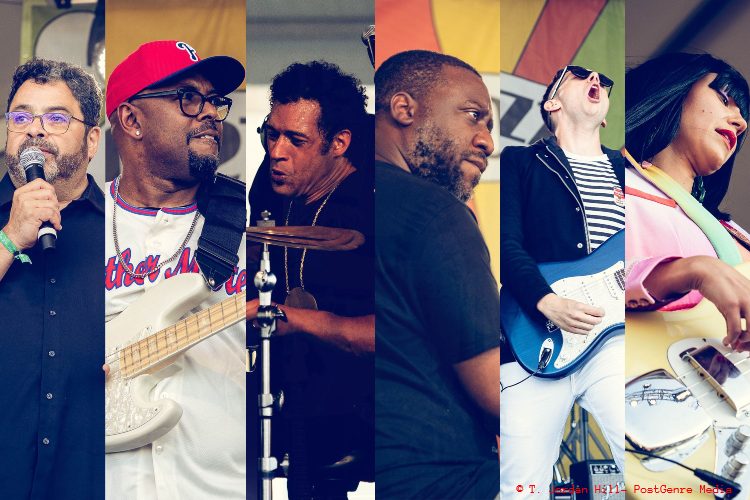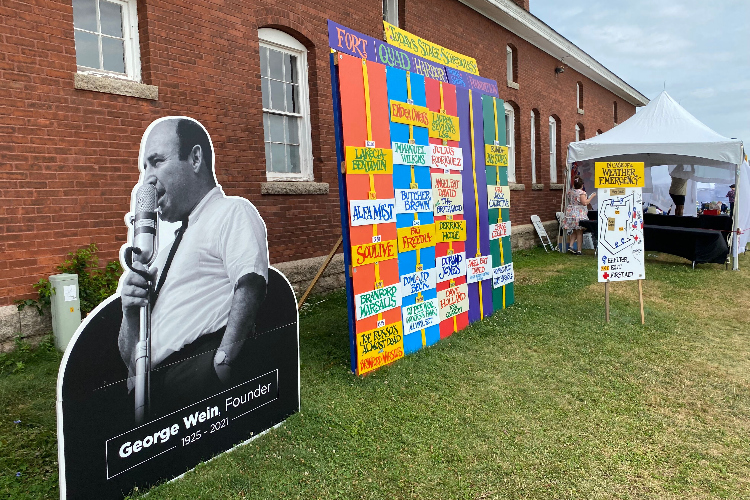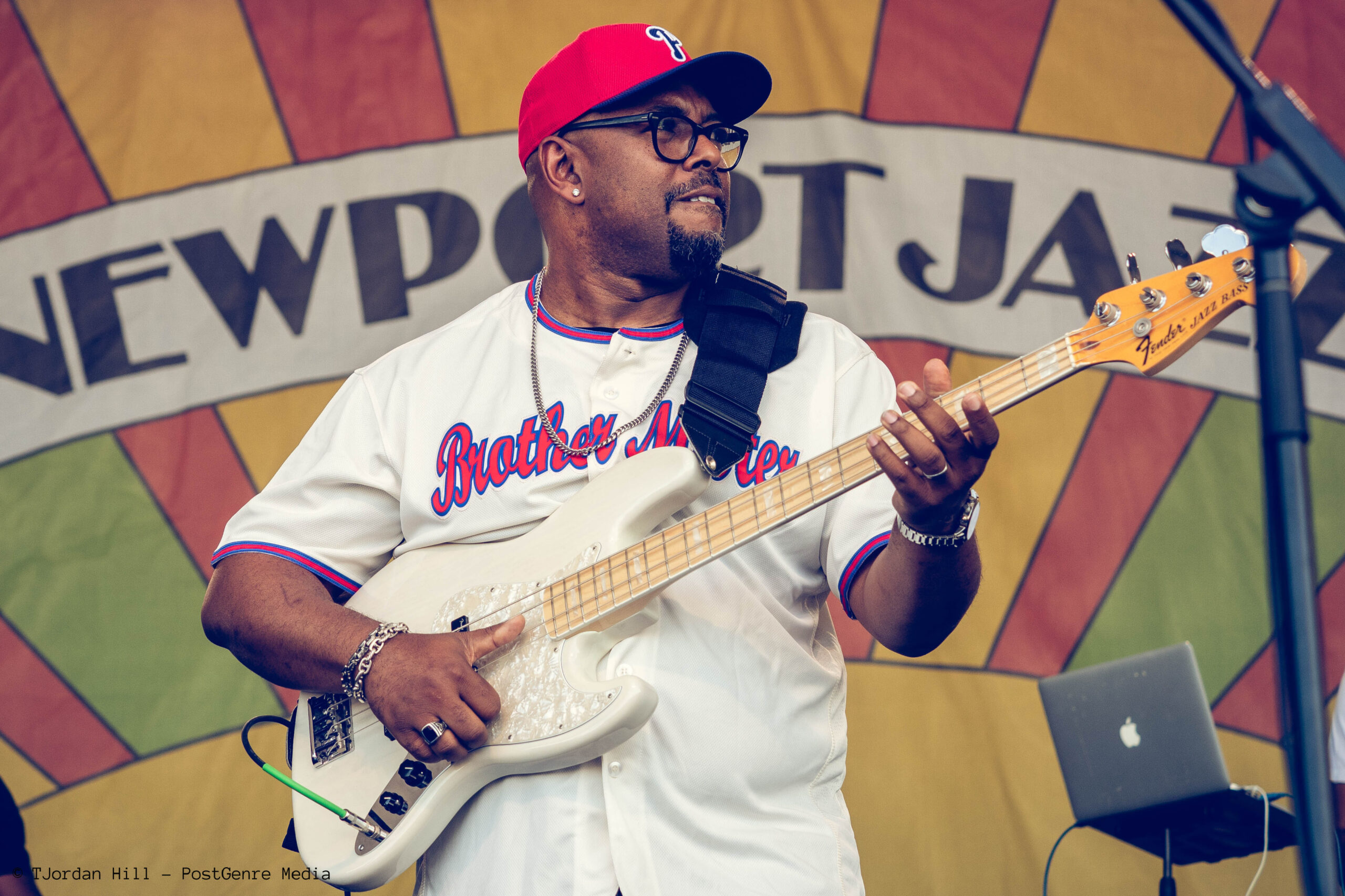Observations from Day One of the 2021 Newport Jazz Festival
|
Getting your Trinity Audio player ready...
|
After a year canceled by COVID-19, audience members on July 31st, the first day of the 2021 Newport Jazz Festival could feel the lingering effects of the pandemic. There was a sixty percent cap on attendance. Half of the stages were closed for business. The Harbor Stage became an area for a tent with picnic tables and folding chairs for attendees to enjoy the food from nearby vendors. The indoor Storyville space was closed off entirely, accessible only to Festival staff. Even the two stages which remained were not their ordinary selves. Organizers cut the Quad in half to provide severely limited covered seating in a space usually covered in folding chairs. The massive Fort Stage was renamed the Lawn Stage and made into a generally scaled-down operation. But the consequences of the coronavirus were perhaps best felt in the music and commentary in each artist’s set. Specifically, two major themes emerged which tie directly back to the pandemic: the importance of family and the meeting of technology and tradition.

The day started with Arturo O’Farrill on the Lawn. While the pianist-bandleader recently announced an album, …dreaming in lions… (Blue Note, 2021) out in September, he did not perform any compositions from the recording in the fiery set. His renowned Afro Latin Jazz Ensemble was reduced to only a quintet with percussionist Victor Pablo Garcia Gaetan, bassist Bam Rodriguez, and Chico’s sons Adam on Trumpet and Zack on drums. One is likely to note that a slight majority of the group has the last name O’Farrill. Obviously, during a time of worldwide calamity, people often clung closer to their families. The bandleader has regularly performed with both Adam and Zack, and their third piece, “Gonky Gonky,” appropriately derives its title from a long-standing family joke. Relatedly, “Pure Emotion,” a slow ballad between piano and trumpet, was penned by Arturo’s father, Chico.


But the band partly shifts the focus on family by questioning how we define the important relationships in our lives. “Compai Doug,” a wild ride up and down the piano, extended the concept to friends. An avant-garde inspired piece composed by Carla Bley pushed it yet further to one’s influences. Another song, once played at the US-Mexico border, draws equally from jazz and Tejano music to suggest that we all view one another as a singular people. Concluding remarks also honed in on the interaction between musicians and listeners: “Where does music exist? It is not in the written music or the beautiful instruments but in the communication between the artist and the audience.”
With A Christian McBride Situation, the Festival’s Artistic Director subdued some of the sentimentality of O’Farrill’s set in favor of time-hopping funkiness. Although aesthetically drawing primarily from jazz-funk and soul of the 1970s, a more accurate analysis would interpret the group’s performance as critically evaluating the interplay between tradition and technology. In large part, this comes from the presence of two artists – DJ Logic and Jahi Sundance – on very modernistic turntables and laptops, though old jazz standards comprised a substantial portion of their repertoire.

An incredibly funky version of Dizzy Gillespie’s eighty-year-old “Night in Tunisia” bridging a gap between bebop, as represented by Alyson William’s scatting, and a George Clintonesque vibe. McBride’s switching between acoustic and electric basses only further strengthened the ability to bridge eras. So did James Francies’ transitions between piano and keyboard. Though confined to one instrument, tenor saxophonist Ron Blake similarly weaved between older jazz sounds and those of the late 20th Century. As to the latter, at times sounding reminiscent of Grover Washington, Jr. Even something as subtle as the band starting before McBride joined them is possibly a reference to the theatricality of the Godfather of Soul with whom the bassist once worked.
The use of technology to coalesce time periods was also present in Makaya McCraven’s Quad set. With “I’m New Here” from We’re New Again (XL Recordings, 2020), the beat scientist’s group with Junius Paul, and Matt Gold built off the raspy vocals of late proto-rapper Gil Scott Heron, made possible by Marquis Hill’s operation of a Macbook. McCraven, one of today’s most compelling bandleaders, often blurs the line between sampling and live production. As such, the introduction of recorded audio should be unsurprising. However, the approach’s expansiveness was even more on display than the version documented on vinyl when Hill rejoined on a mellow flugelhorn.


The piece also provided an opportunity to showcase Paul’s underrepresented vocal chops. While increasingly well-known for his skills as a bassist, his ‘60s soul-inspired voice was a welcome surprise to most in the audience. In vocalizing, “turn around, turn around, come full circle,” he fully closes the loop back to Heron’s statement. A subsequent tune, Tony Wiliam’s “There Comes a Time,” similarly found a space between Miles Davis’ iconic 1955 Newport performance of ‘Round Midnight – with Hill donning a Harmon mute and pressing it tight to the mic – and a heavy R&B influenced groove.
Following McCraven was Robert Glasper’s acoustic trio with bassist Vicente Archer and drummer Justin Tyson, augmented by turntablist Jahi Sundance. The first of the keyboardist’s three performances as the Festival’s Artist-in-Residence tackled both of the themes prevalent throughout the day.
As to the importance of family, Glasper began the set by proclaiming a happy birthday to his one-year-old daughter, Lola, who was on hand for the occasion. Later, in a sprawling rendition of “Stella by Starlight,” he circled the Birthday Song along with several others. And later, he deconstructed the traditional piece’s structure as a tribute to her.

“Stella” was also a centerpiece in showing the use of technology to transcend time. Glasper made a Jarrett-like solo around the theme while citing “Someday My Prince Will Come” as Jahi Sundance’s whirs and scratches weave in and out. Later in the tune, the leader’s keys and voice add snippets of “The Look of Love” and “In a Sentimental Mood,” sounding as if sampled from an earlier recording while turntables increasingly repeat “J Dilla” and “Jay Dee,” referencing one of the most significant composers of the late 20th Century. As Glasper warned before the piece began: “[w]e kinda fucked [the song] up a little bit… [it] may not be by starlight anymore, and her name may not be Stella. Maybe it’s Stacy by the Stairs.”
His humor permeated the entirety of the performance, from claiming to sell an artist pass to the Festival for $200 of bitcoin to jokingly castigating the crowd for not sufficiently cheering for his album, Covered (Blue Note, 2015), and Jahi Sundance responding to the castigation with a pre-recorded audience effect. The interaction – including a young child yelling at Glasper to “just play already”- is of the type possible during only live performances. In some ways, it also harkened back to the long lineage of artists – Louis Armstrong comes to mind – who saw humor as an essential part of getting across their far more serious messages.
Back on the Lawn Stage, Cory Wong led his large ensemble project, the Wongnotes. Hailing from the Twin City area, the influences from the Minneapolis Sound were apparent. The band’s bassist, Sonny T. – who previously recorded with Prince and, to some extent, taught the late Purple Rain guitarist his craft – further underscored these influences. Another of the undeniably talented band’s standouts could be found in Austin-based baritone saxophonist Sly5thAve, who previously created an excellent orchestral tribute to Dr. Dre. But, at times, it seemed like both Sonny T and Sly5thAve were underutilized. The result, though energetic, felt a little flat.


While no one seeks a sloppy band, funk has always been a little rough around the edges. Although Prince was capable of beautiful balladry, he knew when to hit hard and go a little outside of the comfortable range. But with Wong, the blasts and strikes were, if anything, too clean. Too precise. Too polished. Most of the audience seemed to appreciate the set. However, it could have hit a higher mark if the group was a little looser and, frankly, a little nastier.
Friday’s closer was genre-destroying Khruangbin. Although the electric guitar, electric bass, and drums have been around for decades, the Houston power trio provides a sound truly possible only in the post-internet age; one in which ideas from across the globe are accessible with the click of a button. Rock, funk, soul, surf, dub, Eastern, and Middle Eastern ideas all invariably emerge with bassist Laura Lee’s grooving lines as the glue that holds them all together. At times the steadiness of DJ Johnson’s drums even suggests the sampled rhythms of hip hop. At times they sounded like some radio broadcasts of some exotic long-lost culture, one foreign yet familiar.


The audience generally loved the group’s music, calling for, and receiving, an encore. The only criticism for the group was that it did not appear they fully understood the significance of performing at the Newport Jazz Festival. In Cory Wong’s performance, he spoke of how important the event was to music and how humbled he was for organizers to add him to that lineage. In response, Khruangbin guitarist Mark Speer joked that the Jazz and Folk Festivals are essentially the same. It seemed like a missed opportunity to acknowledge the Jazz Festival’s extensive history of pushing the envelope, including its presentation of various artists like Led Zeppelin in 1969. But that the most significant criticism lies in on-stage banter should speak volumes on the superior quality of the music presented; Khruangbin was an excellent end to the first day of festivities.
Observations on Day Two of the 2021 Newport Jazz Festival can be found here. Day Three can be found here.
Except as otherwise noted, all photos by T. Jordan Hill of PostGenre Media




2 thoughts on “Observations from Day One of the 2021 Newport Jazz Festival”